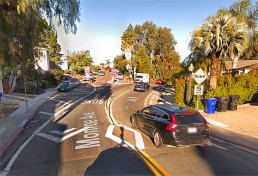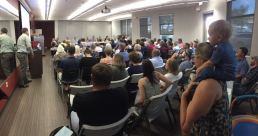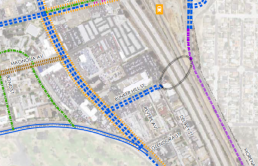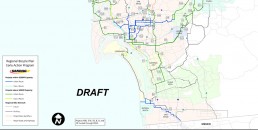Monroe Bikeway: A Bikeway on Paper Only
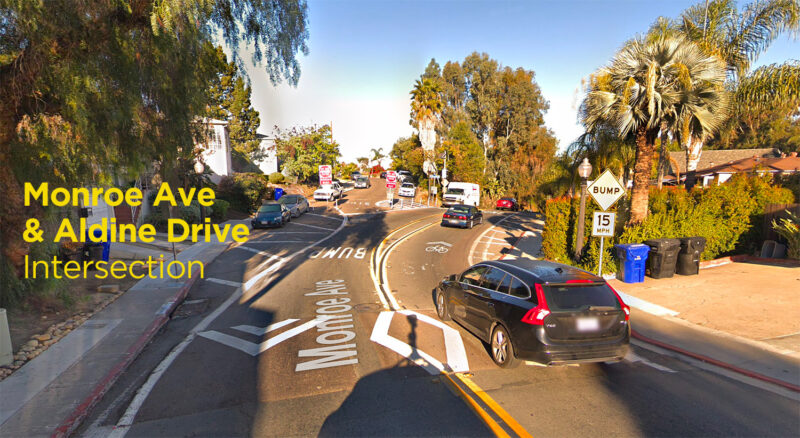
Back in July 2018, we knew the five year old planning effort behind the Monroe bikeway was in trouble. The Kensington-Talmadge community planning group (Ken-Tal) declined to vote on the latest version but they clearly resisted improvements to this corridor. Both Kensington-Talmadge and BikeSD were told that San Diego traffic engineers would study possible solutions to keep traffic on El Cajon Boulevard. It’s unclear if those studies were ever completed. BikeSD warned that Ken-Tal would not allow any solution that allowed for safer conditions on a route connecting Mid-City and San Diego State University area.
On a Friday afternoon, February 21, 2019, the San Diego Association of Governments (SANDAG) announced they were abandoning the current Monroe Bikeway effort.
- - -
Monroe Avenue was identified as a primary bicycle route in both the current Mid-City and College Area community plans. In SANDAG’s alignment analysis in 2014, Monroe was selected for its lower level of stress for bicyclists and its lower cost compared to a cycle track on El Cajon Blvd. At the time, BikeSD and others advocated for cycle tracks on El Cajon Blvd. However, SANDAG and City of San Diego choose to pursue the Monroe segment to connect North Park/Mid-City areas to the neighborhoods around San Diego State University.
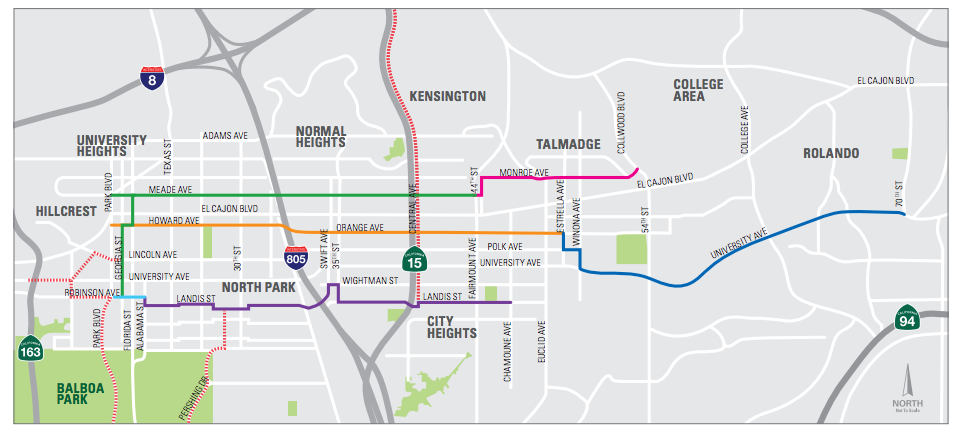
Most of the controversy about the planned bikeway is about the 0.1 mile section of Monroe Ave. from Aldine intersection to 47th street. While this section suffers from high automobile volume, is it really worth abandoning the remaining 1.2 miles of bikeway improvements?
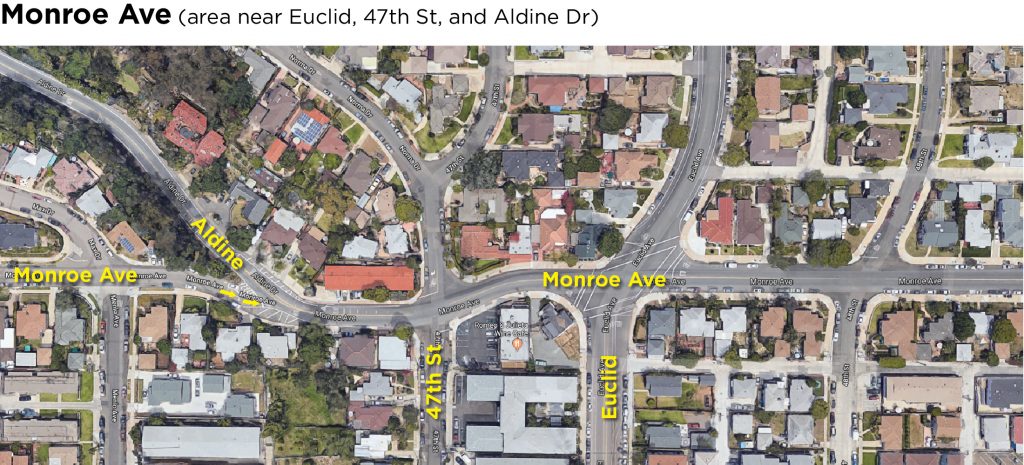
In the past five years, many designs for the intersection of Aldine and Monroe have been proposed but according to SANDAG emails, yet no design was “feasible” to meet of all the constraints imposed from various interested parties. The lack of consensus around a solution doomed the project.
Currently, westbound Monroe and Aldine is a tricky intersection. Aldine Drive is a one of three entry ramps that connect to the Interstate 8 freeway. Area residents also have Fairmount to the west and Collwood to the east, both higher capacity entry points than Aldine Drive. Cyclists traversing this corridor have few choices: dangerous El Cajon Boulevard to the south, or detouring very far south to Orange. Westbound bicyclists on Monroe currently have no legal route to continue on westward besides using the sidewalk.
SANDAG designed multiple concepts to allow Monroe to serve as an east-west bicycle boulevard:
1) Two-way cycletrack on south side of Monroe: (Potential designs here and here.) The possibility had support from some Ken-Tal planning group members who supported trying to prevent left turns from 47th St onto Monroe. However, City of San Diego instructed SANDAG that it would not support any modifications of 47th St. This prevented the design from further evaluation including solving potential challenges of narrow road width. This design was abandoned in 2015.
2) HAWK signal: In 2016 and 2017, SANDAG presented a HAWK signal to allow bicyclists (and pedestrians) to cross the intersection when a bicyclist triggers the HAWK. The Ken-Tal planning group asked for the HAWK removed in 2017. District 9 Councilmember Georgette Gómez’s office did not support the HAWK either. Both CM Gómez and Ken-Tal CPG were concerned about vehicle delay caused by the HAWK. It’s important to note that SANDAG presented traffic studies in 2017 that showed minimal delay (~2 sec). In 2018, it SANDAG presented different traffic model data but that model did not include analysis that included HAWK signal.
3) Bike left turn pocket: This design was SANDAG’s first concept design introduced in 2014. It’s simply a left turn pocket for bicycles only. It legalizes an action that some cyclists already make to continue westward on Monroe. This protected pocket would make it feel safer. It was reintroduced after the HAWK signal was removed from consideration upon Ken-Tal CPG request in 2017. However, City of San Diego traffic engineers rejected this concept in fall of 2018 due to limited sightlines and high traffic volumes. Considering neither sightline nor traffic have changed since 2014, why did City of San Diego engineers not relay their concerns about a bike turn pocket prior to 2018? The lack of communication between City of San Diego and SANDAG is a common theme throughout SANDAGs early action bike program.
4) Bike left turn pocket + 1/2 HAWK signal: An innovative solution proposed by SANDAG combining the turn protection of left turn pocket with HAWK beacon to stop southbound traffic and allow a safe crossing for cyclists. This solution would alleviate any fears about a HAWK signal effects on vehicle delay for Northbound morning commute. It also addressed the concerns of City of San Diego traffic engineers about sightlines. City of San Diego traffic engineers rejected this option.
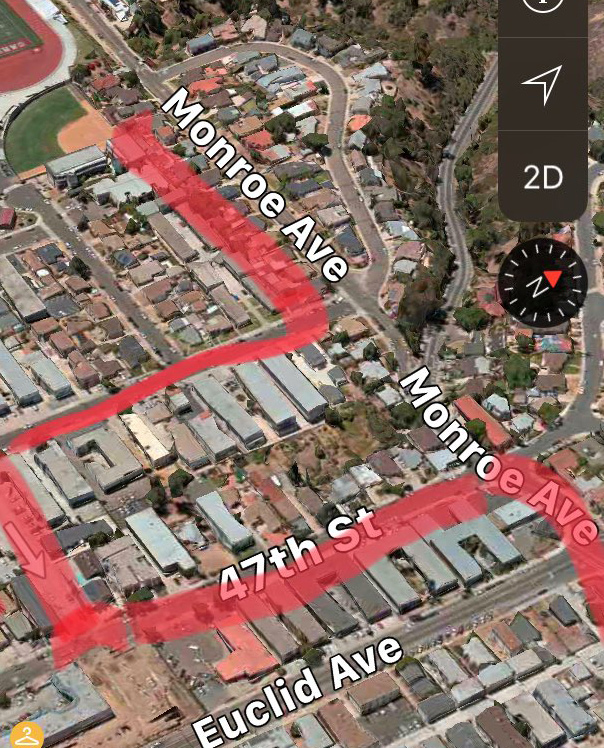
5 ) Meade Ave detour: BikeSD member Howard Blackson had another a suggestion: Why not avoid the tricky Aldine/Monroe intersection with a detour onto Meade Ave for a block (0.4 mile total detour)? The design would have to overcome the current one-way street design of Meade St for this block. Again, this was concept was rejected because City of San Diego would not allow any modifications to 47th St and Monroe intersection. SANDAG’s preferred solution would require some intersection modification to allow westbound cyclists turn safely southbound onto 47th St. (Update: this solution may be back in play.)
Can a future planning grant solve the problem?
The money designated for design phase of the Monroe Bikeway has been exhausted according to SANDAG. In the recent email blast, SANDAG and City of San Diego promised to search for future planning grant opportunities to find a alternative alignment.
Unfortunately, we have recent experience with a mobility planning grant in this exact neighborhood. The City of San Diego received a planning grant to improve mobility for pedestrians and cyclists along the section of El Cajon Blvd parallel to the planned Monroe Bikeway. Again the Ken-Tal planning group led the charge to have bicycle improvements removed from the plan. At the time (2016), Ken-Tal CPG members told KPBS that they supported bicycle routes on side streets, including Monroe but opposed them on El Cajon Boulevard. The Monroe bikeway suffered not because of a lack of funding but a unwillingness to prioritize bicyclists safety.
Until your favorite SANDAG bike project is in construction, everyone should be nervous of a Friday email that announces your neighborhood bike project no longer exists.
SANDAG Monroe Bikeway Held Hostage by Kensington Talmadge Planning Group, Residents
Last week the Kensinton Talamadge Planning Group (Ken-Tal) received an update on the Monroe Bikeway segment of the North Park-Mid City Bikeways from SANDAG (San Diego Association of Governments) staff member Danny Veeh. The Monroe Bikeway is one of the last planned segments of the still-unconstructed North Park Mid City bikeways, and is a 1.3 mile bicycle boulevard connecting from Copley Price YMCA to Collwood Blvd in the College Area:
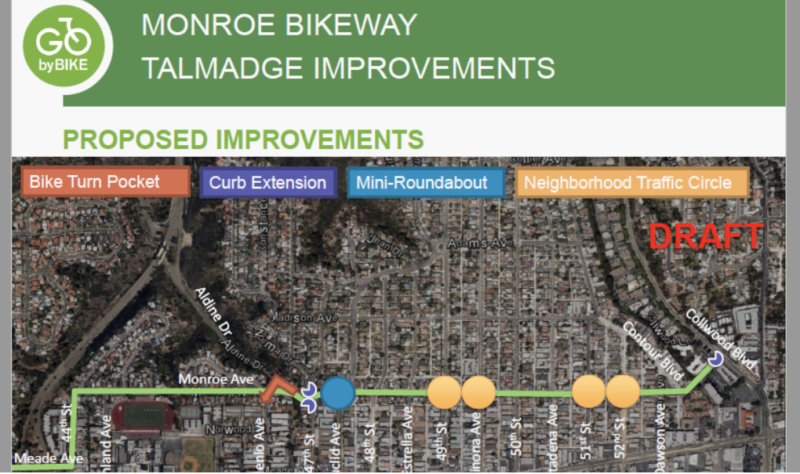
Before summarizing the events of the meeting (hint: it didn’t go well), let’s go over the history of bike lane projects in the Talmadge area:
- October 2013: SANDAG OK’s $200M in early action funding to the bike lane network
- 2014: SANDAG awards City of San Diego with a Complete the (El Cajon) Boulevard study grant, to make the Talmadge section of ECB a “vibrant, safe, pedestrian, bicycle and transit-friendly area”
- July 2015: (Former) Ken-Tal chair David Moty calls on City, SANDAG to make Monroe Bikeway “the earliest part of SANDAG’s Early Action Plan”
- June 2016: SANDAG staff present Monroe Bikeway to Ken-Tal
- September 2016: Ken-Tal unanimously votes against bike lanes on El Cajon Boulevard as part of the Complete the Boulevard study, because of Monroe Bikeway:

- January 2017: San Diego selects Ken-Tal’s bike-unfriendly, watered-down redesign of El Cajon Boulevard
- July 2017: SANDAG staff present Monroe Bikeway modifications to Ken-Tal
- July 2018: SANDAG staff present more Monroe Bikeway modifications to Ken-Tal, including removal of HAWK signal at Aldine at the request of Talmadge residents
So after multiple years of Monroe Bikeway planning, traffic studies, traffic modeling, presentations to planning groups/planning group subcommittees/maintenance assessment districts/community councils, modifications to those presentations, more modifications to those presentations, and votes against other bikeways because of Monroe Bikeway—what did Ken-Tal planning group do? They prepared to vote against the Monroe Bikeway.
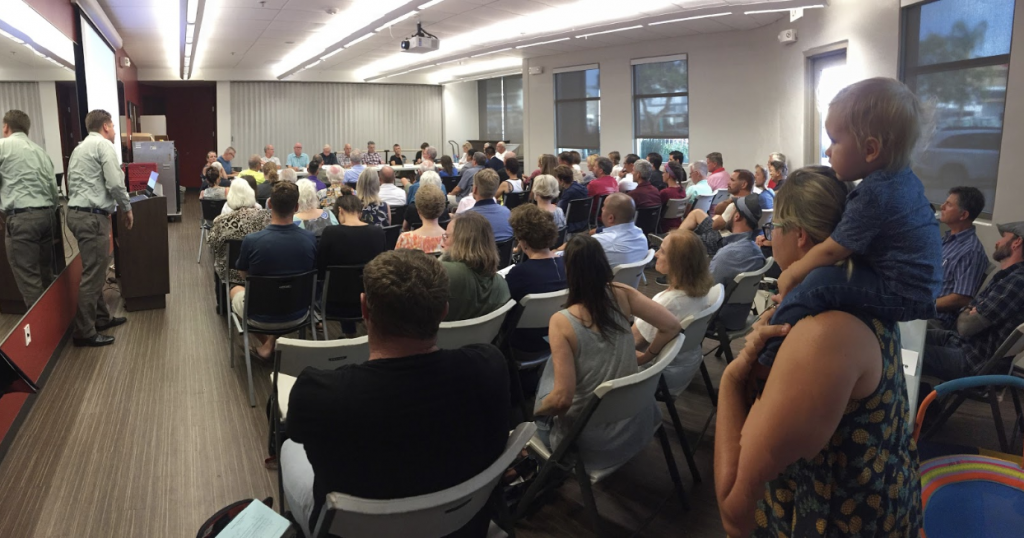
The overriding issue that long predates this project is auto congestion on Monroe during rush hour. While Ken-Tal and the City have implemented many attempts to address this issue, the entire community has never been satisfied. The city tried stop signs in 2013, left turn restrictions from 47th to Monroe in 2015, and Ken-Tal floated closing 47th at Monroe and a traffic island that restricted turns. Ken-Tal has also voted to widen El Cajon Boulevard at Fairmont, directly contradicting the city’s safety efforts on this deadly street for pedestrians. These actions have exposed a bitter community divide over a basic equity issue: Should auto access to one of the most heavily-used two-lane roads in the city be limited to wealthier north Talmadge residents, or do lower income residents in south Talmadge and City Heights have a right to this public road too? The City of San Diego answered this question by instructing SANDAG to design the bikeway without altering access to Monroe from 47th.
Despite Ken-Tal chair Don Taylor’s reminders that congestion issues are well beyond the scope and budget of the bikeway, Talmadge residents and board members continue to hold the Monroe Bikeway project hostage over this neighborhood dispute. In 2017, SANDAG staff was prepared to move the project forward for environmental clearance but delayed the project for 1 year to appease Ken-Tal’s concerns. As Ken-Tal requested, a HAWK beacon was replaced with a bicycle only left turn pocket in the most recent design. Despite this concession, many board members still refused to support the project. Remarkably, former Ken-Tal chair David Moty removed his support as a result of this concession.
When community members oppose a project for reasons that directly contradict each other, how is SANDAG ever expected to achieve the elusive “consensus” required for bike lane projects that is not required for freeway widenings and road expansions? This is the main reason why nearly every SANDAG bike lane project is behind schedule: attempting to appease armchair engineer residents who write 62-page manifestos demanding the city subsidize his lack of off-street parking, or Ken-Tal board members who attack the Monroe Bikeway for failing to improve safety—while offering no viable alternative. A Talmadge attorney even insisted the California Environmental Quality Act prohibits the bike lane—despite the governor signing two laws that prevent this environmental policy from being perverted to kill bike lanes.
Meanwhile, here’s fomer Ken-Tal chair Moty in 2015, offering full support for the Monroe Bikeway: “SANDAG staff are faced with challenges enough elsewhere, we should not create challenges for them here where overall community support is strong. The KTPG does not believe this is the city’s intent, and hopes the city will give its full support to SANDAG’s plan and remove any roadblocks to its implementation.”
As Ken-Tal prepared to vote “no” on the Bikeway (with chair Taylor, Transportation Subcommittee chair Sean Harrison and Deborah Sharpe the only apparent “yes” votes), District 9 City Councilmember Georgette Gomez asked the board to postpone their vote. Gomez was present for the full 2 hours of contentious debate about the Bikeway and does not support 24-hour left turn restrictions onto Aldine from Monroe. She promised to take the feedback from the community planned to work with SANDAG and City of San Diego staff. Councilmember Gomez has been vocal supporter of active transportation in her role on SANDAG’s Transportation Committee and BikeSD is hopeful her leadership will result in a high-quality Monroe Bikeway.
Yet so far Ken-Tal’s efforts to delay the Monroe Bikeway have been successful. As we’ve seen with the Uptown Bikeway and in communities across the country, this is a proven model to continually delay and water down bike lanes, until eventually killing them. If San Diego is going to implement any of SANDAG’s bicycle projects, city leaders must not give into “advisory” planning groups, who actually hold a powerful veto over bike infrastructure. Further, Ken-Tal’s long history of placing its own interests over the larger Mid-City community (attempting to move planned retail away from El Cajon Boulevard; voting to worsen pedestrian safety on ECB) is another reason why planning groups should be consolidated—at a minimum.
For supporters of the bikeway, the next big timeline will be a CEQA exemption hearing. Prior to the recent Ken-Tal planning meeting, SANDAG planned for a September hearing. Any delay will add to concerning pattern of City of San Diego and SANDAG tolerating delays to SANDAG’s early action bicycle plan.
Balboa Station Plan: Does it solve the mobility issues around Balboa Ave station?
As anyone that has ridden along the Rose Canyon Bike Path or in the UTC area knows, SANDAG is in the process of extending the Mid-Coast Trolley from Old Town to UCSD and UTC area. The potential of this $2.1 billion investment can only fully be realized by enhancing the accessibility of the stations to surrounding neighborhoods. The City of San Diego is currently drafting a planning document for the area around the Balboa Avenue Station. Eventually, the plan will be voted on by San Diego’s City Council. (The current draft plan is can be read here and the image below shows the area being included in the plan.)

Currently, the area depends on a very autocentric roadway design. The proximity of Interstate 5 and on-ramps and off-ramps into the area bring high speed traffic directly into the plan area. The northbound I-5 exit onto Mission Bay Drive encourages drivers to maintain freeway speeds into Pacific Beach. Despite high volume of bicycle traffic, Mission Bay Drive has no bicycle lanes. Rose Creek Bicycle Path is an alternative to this high speed road but the utility of this path is constrained by a narrow path, lack of lighting and frequent homeless encampments. Despite most businesses in the area having large parking lots, Mission Bay Drive allows free street parking. Traveling east of mission bay drive on Balboa Avenue, cyclists contend with high speed traffic, high speed interchanges with Morena Boulevard and an uphill climb into the Clairemont neighborhood. In short, the current conditions need improvement and are a barrier to area residents trying to access Mission Bay, the beach areas, and generally traversing the intersection of Balboa Avenue and I-5 / Morena Boulevard.

While the draft Balboa station does not fix all of these issues, it does attempt to make improvements.
For non-bicycle specific infrastructure, the plan supports the elimination of free rights and other high speed conditions in the below examples.
- Removal of freeway style ramp eastbound Balboa Ave to Morena Blvd ramp
- Changing an I-5 off ramp onto Balboa Ave to a signalized (albeit widened) off ramp
- Add a a traffic signal at westbound Balboa Ave & Morena ramps and remove free right turn ramps
Recommended Bicycle specific infrastructure
- Enhance Rose Creek Path
- Class II bike lanes on Mission Bay Drive
- Class II bike lanes from Santa Fe st to Moraga St (width permitting)
- Class II bike lanes on Bunker Hill road
- Class III (Sharrows) on Garnet from Mt Soledad Road to Santa Fe Street
- Class IV (cycletrack) on Santa Fe Street (Purpose of this cycletrack appears to allow cyclists to access Rose Canyon and points north since Santa Fe is recommended to be southbound only in the plan)
- Class IV (cycletrack) Morena Blvd (west side) from Gesner to Balboa Station
Overall, the plan recommends a lot of improvements that will help bicyclists. As a frequent commuter through the area, I am excited about the bike lanes on Mission Bay Drive. The current state requires a bicyclist to control the lane with honking, hostile motorists. Removing some automobile parking for a bike lane is needed to create high quality, safe bike lane.
So for the bicyclist commuting north/south through the area, this plan provides improvements. However, it does not appear that this plan does anything to slow freeway traffic from I-5 as it exits from I-5 northbound. This should be corrected as it is a major hazard.
Biking to and through the plan area from Pacific Beach will remain a challenge. Grand and Garnet Avenues are the only roads that travel over Rose Creek. In the draft plan, sharrows (class III) are recommended on Garnet to reach the station area. The Pacific Beach Planning Group is not happy with that recommendation. The PB planning group calls the recommended sharrows “unacceptable.”
A pedestrian/bicyclist bridge crossing I-5 from Bunker Hill St is proposed in the plan. This would provide a stress-free route for bicyclists to access the trolley station. The PB planning group asked for the plan to include the pedestrian/bicycle bridge over I-5 in the earliest phase. However, a funding source and commitment needs to identified. Since it helps the City of San Diego reach both Climate Action Plan goals and maximize the investment in the expanded trolley, this project should be a high priority for the city.

The city is still looking for feedback on its plan. Please ask the city to prioritize safe bicycle routes (including the I-5 bridge!) in the plan. Provide feedback to city of San Diego planning department, Michael Prinz, Senior Planner, Planning Department, Mprinz@sandiego.gov. Another option to give feedback is the city provided website. As you probably suspect, not everyone wants bicycles accommodated. Don’t allow the below comment represent your views and dilute the potential great improvements that could be implemented.
![]()
2018: Hopefully a year of progress for bicyclists
In 2018, San Diego needs to take another step forward towards becoming a world class bicycling city. While the streets of San Diego have become increasingly bike-friendly, San Diego needs more than incremental changes to meet our safety and climate action goals. Below are a few of the initiatives we will be watching for improvements. If you have other suggestions, please contact us through email (talk@bikesd.org) or twitter (@bikesd).

Downtown Mobility Plan
The plan to redesign our auto-centric downtown area was approved in June 2016, but what city council passed was primarily a planning document. Will the final design reflect the world-class, high quality bikeway design that downtown deserves? City staff needs to resist the temptation to accommodate NIMBY street parking concerns that would compromise the bikeway quality and residents’ safety. We hope city staff will continue to work with bicycle advocates to ensure success.
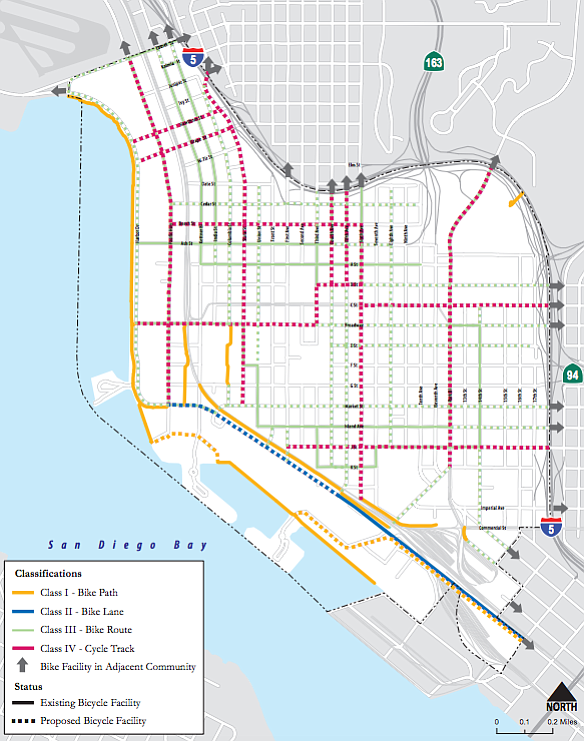
SANDAG Early Action Programs
SANDAG approved 40 early projects throughout the county in 2013. The stated goal was for projects to be completed within 10 years. As KPBS recently highlighted, SANDAG has consistently postponed project timelines. If new bikeways can be installed in Manhattan in just one year, why do they take several times that in San Diego? In 2018, we will hopefully celebrate the groundbreaking for 1st segments of Uptown Bikeway and North Park-Mid City bikeways.
Resurfacing & Repurpose
As the Mayor office fulfills his pledge to resurface streets, any street on the city’s bicycle plan should accommodate the facility specified in master plan. While efficient, this resurface/repurpose effort does not allow for a large network of bicycle infrastructure to be built. Also, road diets and the removal of parking require community approval beforehand. The city should remove this unnecessary layer of approval to implement its bicycle master plan and climate action plan (both approved unanimously by city council). While this layer of community approval is unnecessary, it reinforces the need for BikeSD supporters to join your local community planning group.
Community Plan Updates
Every community plan update has a mobility element. Many of San Diego community plans are outdated. BikeSD supporters should advocate for safe bicycling facilities in all community plans. If a bicycle facility is on an approved community plan, it will be easier to advocate for it in the future. Currently the city is working on Barrio Logan, Midway, Old Town, Kearny Mesa, Clairemont, and Mission Valley community plans. (Please let us know if we missed any!!!)
Bicycle Advisory Committee Strategic Implementation Plan
For the past couple of years, a group of appointed volunteers has worked with city staff on implementing the city’s bicycle master plan. As KPBS reported, the plan was delayed after bicycle advocates voiced concerns. City Council should approve an implementation plan that satisfies the advisory committees concerns. (As an aside, the bicycle advisory committee currently has opens positions, interested BikeSD supporters should contact their respective council district offices if interested in joining.)
Parking
We don’t believe the storage of private property on public streets is the best use of our precious space. As of start of 2018, the city has not allowed any bicycle infrastructure that even removed 1 parking spot—even when abundant off-street parking exists. This needs to change! In fact, the city needs to implement a parking management strategy that is more than “more!!” Start with Donald Shoup’s ideas.
Don't forget to attend our next Bike San Diego Meetup!
When: March 6 at 6pm
Where: Iron Pig Alehouse (Pacific Beach)
We'll be meeting on March 6 in Pacific Beach at Iron Pig Alehouse for an evening of community, conversation, and discussion of Community Planning Groups. Circulate San Diego will be joining BikeSD to discuss how residents can (and should) get involved in local planning groups to help create a world-class city for biking. Doors open at 6, we'll have a presentation and panel discussion at 7, which will be followed up by a social hour.
RSVP
Your Favorite SANDAG Bicycle Project is Most Likely Delayed
Often, I am asked about what upcoming bicycle project is the most exciting. I love all bicycle projects but I often suggest upcoming SANDAG projects. Whether I select Pershing Bikeway or a North Park - Mid City Bikeway, my audience usually groans. Typical responses include “Is that actually going happen?” or “Are the NIMBYs just going to win like they did in Hillcrest?” Frankly, I never have a convincing counter argument.
For supporters of SANDAG’s planned bicycle projects, the excitement has waned as the planning process has dragged on. SANDAG's Regional Bike Plan Early Action Program (EAP) was approved by the SANDAG board in 2013. The EAP's goal was to have the entire project list built in 10 years. Below is the project list sorted by priority:
For city of San Diego residents, the highest priority projects, Uptown and North Park Mid City Bikeways, brought a lot of enthusiasm. The first outreach meetings for Uptown Bikeway and North Park Mid City Bikeway was 2013. At the time, SANDAG project told the community advisory groups to expect construction in 2016. Currently, neither of these of projects have started construction.
In the table below, we highlighted all of the SANDAG current bicycle projects in the city of San Diego. Comparing the past 2 program budgets shows just quickly these projects can be delayed multiple years. Will SANDAG finish the EAP projects by 2023 as promised? From the FY 2017 to FY2018 program budgets, many bikeways suffered opening delays of greater than 1 year. All segments of SANDAG’s EAP top priority projects, Uptown Bikeway & North Park Mid-City, suffered delays of at least 1 year.
We understand that project delays occur. Our concern is that delays are related to a lack of political will to get these projects completed. SANDAG staff is directed to spend far too much time mitigating the smallest of NIMBY concerns relating to bikeways. We need City of San Diego elected leadership to champion these projects and demand results. The City of San Diego is represented by Council President Myrtle Cole and Mayor Kevin Faulconer on the SANDAG board. On the Transportation Committee, Councilmember Georgette Gomez represents the City of San Diego. We encourage our elected officials to review the Bicycle EAP progress. These projects complement the City’s Vision Zero goals and Climate Action Plan.

